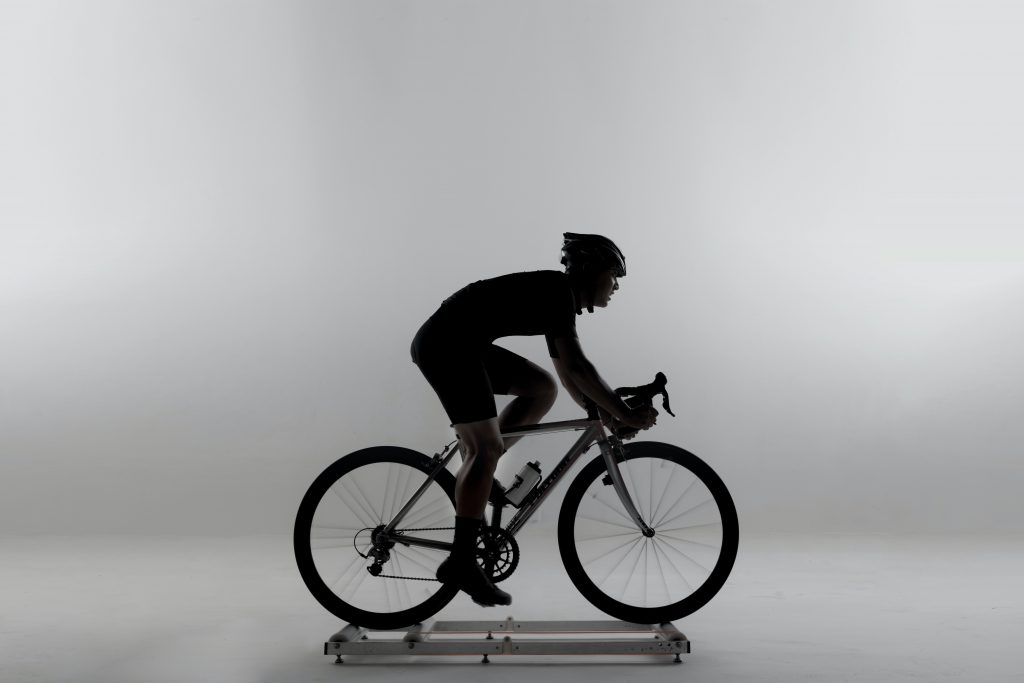Turbo Trainer Tips – Getting The Most From Your Purchase

When it’s impossible to get outside and ride in the real world many cyclists turn to a Turbo Trainer to keep the legs turning. However getting the most from your trainer requires a bit of thought and preparation.
Which Type of Turbo Trainer?
Turbo Trainers come in a number of different varieties and complexities:
- Rollers
- ‘Dumb’ wheel on trainer
- ‘Smart’ wheel on trainer
- ‘Smart’ direct drive trainer
Rollers – These are essentially a rolling road for your bicycle. The rear wheel sits between two rollers which are connected by a belt to a third roller on the front wheel. Other than the bicycles gearing they don’t generally provide any way to vary the resistance that the rider feels. The rider needs to balance the bicycle stop avoid toppling off the trainer.
‘Dumb’ wheel on trainer – These types of trainer hold the rear wheel of the bicycle off the ground and sit it on a roller that can be manually adjusted for resistance. They are termed ‘dumb’ because the rider has to vary the amount of resistance applied to the roller manually, usually by means of a thumb lever attached to the handle bars. Their major advantage is that the riders don’t need to balance the bike on the trainer.
‘Smart’ wheel on trainer – These are a development of the dumb trainer where the resistance can be controlled electronically / automatically. This control is usually done via a phone / tablet app or PC program. Having automatic resistance control means that it’s possible for the trainer to simulate changes in gradient on a ride providing a more realistic experience.
‘Smart’ direct drive trainer – This is the ultimate in indoor turbo trainers where the wheel is removed from the bicycle. The unit will have a gear cassette that is the same as the one used on the bicycles wheel, and gives the rider more ‘feel’ than a wheel on trainer. Some of the most advanced units also have ways to tilt the bicycle to physically simulate hills and cornering. These tend to be the most expensive type of trainer.
Note – if you’re considering a wheel on turbo trainer then you may need to also invest in a ‘turbo tyre’. Turbo trainers are notoriously hard on tyres a turbo tyre is a special, very hard wearing or solid tyre.
Preparation
Once you have settled on your trainer you’ll be keen to jump on and give it a whirl, but the correct preparation is key.
Location – Turbo training can be noisy, pay careful attention to where you set up. Putting your trainer on a hard floor will cause a lot of vibration and noise. Putting it on a thin mat will absorb most of the vibration. The last thing you need is your exercising causing noise all around your house.
Have a safe area – The last thing you need is for pets or small children to be coming in to contact with you or your bike. If you can have separate room all the better, if not make sure you are cordoned off.
Ventilation – Riding on a turbo is hot work. Because there’s no natural wind you will get hot, have a fan handily placed to cool you down.
Sweat – Because you’ll be getting very hot you’ll sweat a lot. Make sure you have something to catch any sweat that may drip on to the floor or bike itself.
Hydration – Just because you’re not out on the road doesn’t mean you can skimp on drinking. Make sure you have water or for a longer session an energy drink to hand.
Entertainment
Riding a static turbo trainer can be boring to say the least. If you’re doing anything other than the shortest of rides then you will need a distraction. Depending on what trainer you have the options will vary.
- If you have a smart turbo you may be able to link it to an online interactive service. Zwift, and Bkool are a couple of the most common, and these services provide a virtual view for your ride. They can change the resistance based on the terrain as well as slow and speed up the virtual view. To get the best of the service you may need additional hardware though.
If you have a basic trainer (or don’t want to use an interactive service) then you’ll need to sort out your own distractions:
- Background music – headphones or a bluetooth speaker linked to a phone / tablet with some music is a great distraction.
- Videos / TV – If you don’t want music then something visual might be for you. If you can hook up a screen the options are endless: YouTube, Netflix, Broadcast TV can all take the edge off an indoor ride.
- Challenge yourself – If you have a smart trainer or some way to measure distance / speed on a dumb trainer then create your own challenges. Try going faster or further in your allotted time to give you something to focus on.
Precautions
Riding on a turbo trainer can put strain on your bike. Bicycles are not designed to be clamped in one position and have stresses put through them. Putting your bike on a turbo may actually invalidate any warranty, and make sure you inspect your bike regularly especially at stress points such the rear wheel dropouts and bottom bracket shell.
Cleaning your bike regularly is very important. On a turbo trainer your sweat will drop more on to the bike and over time will cause corrosion. Particularly prone are the top tube, and also the handlebars as sweat will seep through bar tape. We would recommend getting and using an old bike for turbo work if you possibly can. If you don’t have access to an old bike try to cover the vulnerable areas.
Don’t strain yourself. Much like the stresses put on a bike on a turbo trainer the body reacts differently to a stationary bike. While it’s good to challenge yourself don’t go overboard. Because your body moves differently there’s the possibility of increased injury. The idea of the turbo is to maintain fitness, going gentler and more frequent will be best for both you and the bike.
Overall turbo trainers are great tools for maintaining and improving fitness when it’s not possible to ride on the road. Utilising the tips above will help you to get the most out of your turbo sessions. But, we always recommend getting outside when you can and our article on maintaining winter motivation will help
If you found this advice helpful please consider supporting us by buying a tea at www.buymeacoffee.com/cyclinglabs








